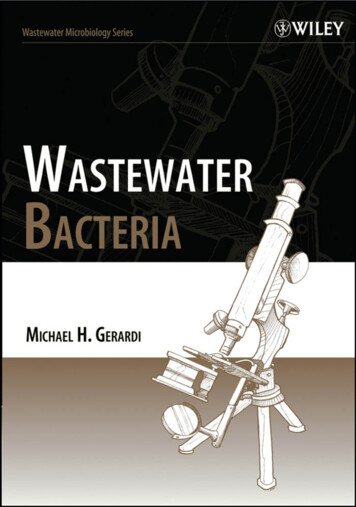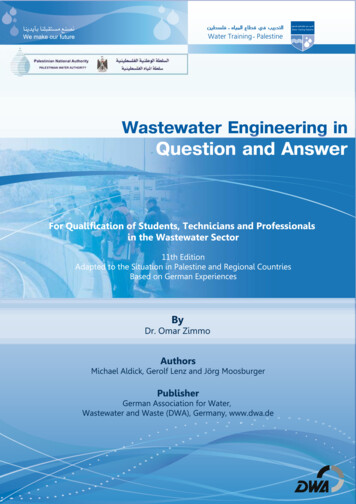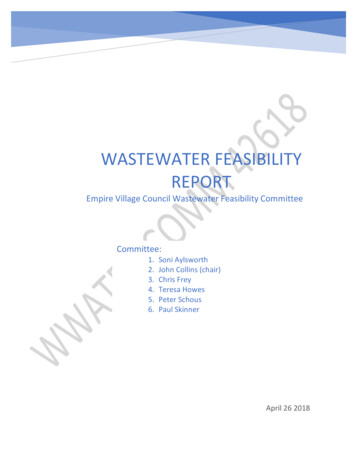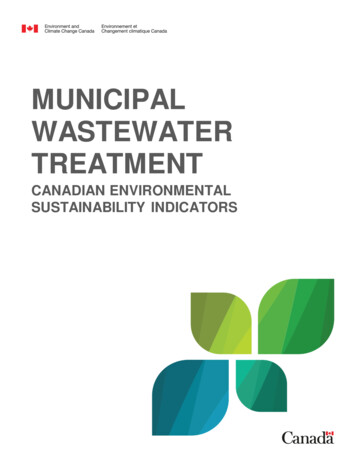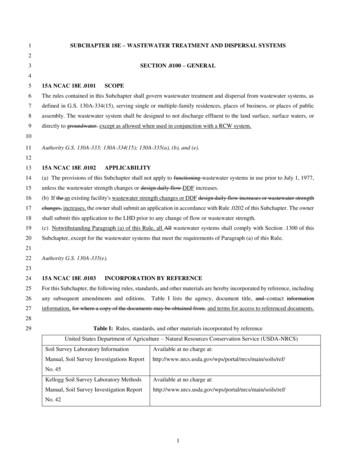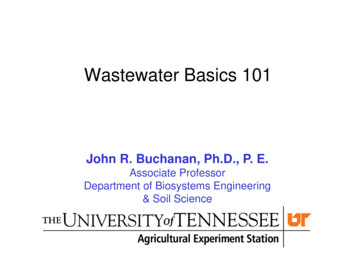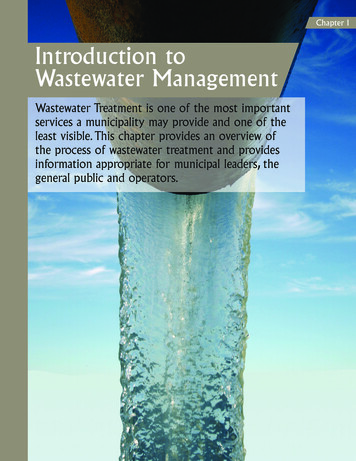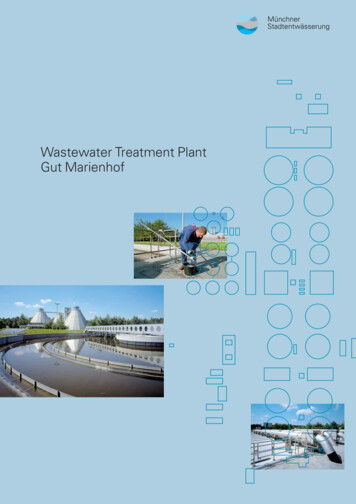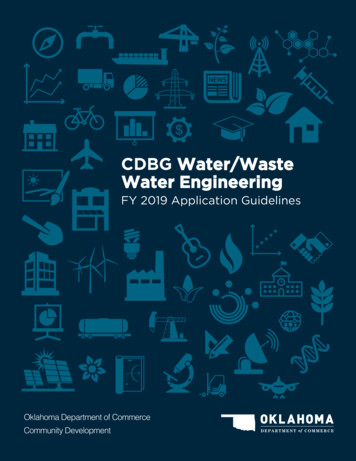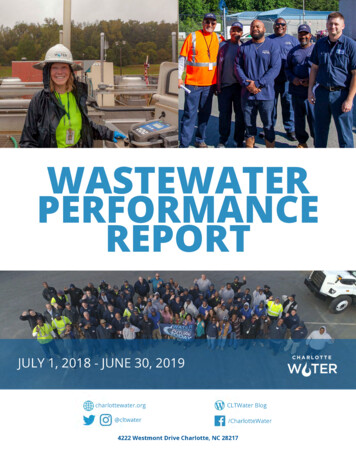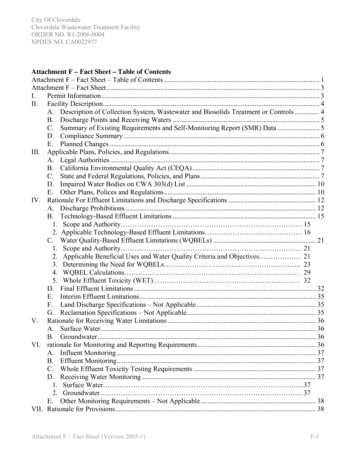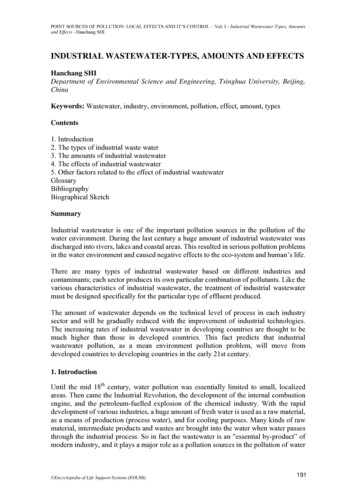
Transcription
POINT SOURCES OF POLLUTION: LOCAL EFFECTS AND IT’S CONTROL – Vol. I - Industrial Wastewater-Types, Amountsand Effects - Hanchang SHIINDUSTRIAL WASTEWATER-TYPES, AMOUNTS AND EFFECTSHanchang SHIDepartment of Environmental Science and Engineering, Tsinghua University, Beijing,ChinaKeywords: Wastewater, industry, environment, pollution, effect, amount, typesContents1. Introduction2. The types of industrial waste water3. The amounts of industrial wastewater4. The effects of industrial wastewater5. Other factors related to the effect of industrial wastewaterGlossaryBibliographyBiographical SketchSummaryIndustrial wastewater is one of the important pollution sources in the pollution of thewater environment. During the last century a huge amount of industrial wastewater wasdischarged into rivers, lakes and coastal areas. This resulted in serious pollution problemsin the water environment and caused negative effects to the eco-system and human’s life.There are many types of industrial wastewater based on different industries andcontaminants; each sector produces its own particular combination of pollutants. Like thevarious characteristics of industrial wastewater, the treatment of industrial wastewatermust be designed specifically for the particular type of effluent produced.The amount of wastewater depends on the technical level of process in each industrysector and will be gradually reduced with the improvement of industrial technologies.The increasing rates of industrial wastewater in developing countries are thought to bemuch higher than those in developed countries. This fact predicts that industrialwastewater pollution, as a mean environment pollution problem, will move fromdeveloped countries to developing countries in the early 21st century.1. IntroductionUntil the mid 18th century, water pollution was essentially limited to small, localizedareas. Then came the Industrial Revolution, the development of the internal combustionengine, and the petroleum-fuelled explosion of the chemical industry. With the rapiddevelopment of various industries, a huge amount of fresh water is used as a raw material,as a means of production (process water), and for cooling purposes. Many kinds of rawmaterial, intermediate products and wastes are brought into the water when water passesthrough the industrial process. So in fact the wastewater is an "essential by-product” ofmodern industry, and it plays a major role as a pollution sources in the pollution of water Encyclopedia of Life Support Systems (EOLSS)191
POINT SOURCES OF POLLUTION: LOCAL EFFECTS AND IT’S CONTROL – Vol. I - Industrial Wastewater-Types, Amountsand Effects - Hanchang SHIenvironment.2. The types of industrial waste waterThere are many types of industrial wastewater based on the different industries and thecontaminants; each sector produces its own particular combination of pollutants (seeTable 1).SectorIron and steelTextiles and leatherPulp and paperPetrochemicals andrefineriesChemicalsNon-ferrous metalsMicroelectronicsMiningPollutantBOD, COD, oil, metals, acids, phenols, andcyanideBOD, solids, sulfates and chromiumBOD, COD, solids, Chlorinated organiccompoundsBOD, COD, mineral oils, phenols, and chromiumCOD, organic chemicals, heavy metals, SS, andcyanideFluorine and SSCOD and organic chemicalsSS, metals, acids and saltsTable 1: Water Pollutants by the Industrial SectorThe metal-working industries discharge chromium, nickel, zinc, cadmium, lead, iron andtitanium compounds, among them the electroplating industry is an important pollutiondistributor. Photo processing shops produce silver, dry cleaning and car repair shopsgenerate solvent waste, and printing plants release inks and dyes. The pulp and paperindustry relies heavily on chlorine-based substances, and as a result, pulp and paper milleffluents contain chloride organics and dioxins, as well as suspended solids and organicwastes. The petrochemical industry discharges a lot of phenols and mineral oils. Alsowastewater from food processing plants is high in suspended solids and organic material.Like the various characteristics of industrial wastewater, the treatment of industrialwastewater must be designed specifically for the particular type of effluent produced.Generally, industrial wastewater can be divided into two types: inorganic industrialwastewater and organic industrial wastewater.2.1 Inorganic industrial wastewaterInorganic industrial wastewater is produced mainly in the coal and steel industry, in thenonmetallic minerals industry, and in commercial enterprises and industries for thesurface processing of metals (iron picking works and electroplating plants). Thesewastewaters contain a large proportion of suspended matter, which can be eliminated bysedimentation, often together with chemical flocculation through the addition of iron oraluminum salts, flocculation agents and some kinds of organic polymers.The purification of warm and dust-laden waste gases from blast furnaces, converters, Encyclopedia of Life Support Systems (EOLSS)192
POINT SOURCES OF POLLUTION: LOCAL EFFECTS AND IT’S CONTROL – Vol. I - Industrial Wastewater-Types, Amountsand Effects - Hanchang SHIcupola furnaces, refuse and sludge incineration plants, and aluminum works results inwastewater containing mineral and inorganic substances in dissolved and undissolvedform.The pre-cooling and subsequent purification of blast-furnace gases requires up to 20 m3water per t of pig iron. On its way into the gas cooler the water absorbs fine particles ofore, iron and coke, which do not easily settle. Gases dissolve in it, especially carbondioxide and compounds of the alkali and alkaline earth metals, if they are water-soluble orif they are dissolved out of the solid substances by gases washed out along with them.In the separation of coal from dead rock, the normal means of transport and separation iswater, which then contains large amounts of coal and rock particles and is called coalwashing water. Coal-washing water is recycled after removal of the coal and rockparticles through flotation and sedimentation processes.Other wastewater from rolling mills contain mineral oil and require additionalinstallations, such as scum boards and skim-off apparatus, for the retention and removalof mineral oils. Residues of emulsified oil remaining in the water also need chemicalflocculation.In many cases, wastewater is produced in addition to solid substances and oils, and alsocontains extremely harmful solutes. These include blast-furnace gas-washing wastewatercontaining cyanide, wastes from the metal processing industry containing acids oralkaline solutions (mostly containing non-ferrous metals and often cyanide or chromate),wastewater from eloxal works and from the waste gas purification of aluminum works,which in both cases contain fluoride. Small and medium sized non-metallic-mineralsplants and metal processing plants are so situated that they discharge their wastewaterinto municipal wastewater systems and have to treat or purify their effluents beforedischarge, in compliance with local regulations.2.2 Organic industrial wastewaterOrganic industrial wastewater contains organic industrial waste flow from those chemicalindustries and large-scale chemical works, which mainly use organic substances forchemical reactions.The effluents contain organic substances having various origins and properties. These canonly be removed by special pretreatment of the wastewater, followed by biologicaltreatment. Most organic industrial wastewaters are produced by the following industriesand plants: The factories manufacturing pharmaceuticals, cosmetics, organic dye-stuffs, glueand adhesives, soaps, synthetic detergents, pesticides and herbicides;Tanneries and leather factories;Textile factories;Cellulose and paper manufacturing plants;Factories of the oil refining industry;Brewery and fermentation factories; Encyclopedia of Life Support Systems (EOLSS)193
POINT SOURCES OF POLLUTION: LOCAL EFFECTS AND IT’S CONTROL – Vol. I - Industrial Wastewater-Types, Amountsand Effects - Hanchang SHI Metal processing industry.As examples, some special types of wastewater produced by the industries mentionedabove are briefly introduced as follows.Wastewater produced from the pharmaceutical industriesThe quality of the wastes from the production of pharmaceuticals varies a great deal,owing to the variety of basic raw materials, working processes and waste products. It is acharacteristic of the pharmaceutical industry that very many products as well asintermediate products are manufactured in the same plant. Thus different kinds of effluentwith widely varying qualities flow from the different production areas.For large chemical industries it is also usual to manufacture pharmaceutical productstogether with other chemical products. Some times waste substances include theextraction residues of natural and synthetic solvents, used nutrient solutions, specificpoisonous substances, and many other organics.The wastewater produced by the pharmaceutical industry has a very bad quality forwastewater treatment. Usually the concentration of COD is around 5000 – 15000 mg/L,the concentration of BOD5 is relative low, and the ratio of BOD5 /COD is lower than 30%which means the wastewater has a poor biodegradability. Such wastewater has bad colorand high (or low) pH value, and it needs a strong pretreatment method, followed by abiological treatment process with a long reaction time.Wastewater produced by tannery plantsA tannery is one of the most water intensive plants, and its production process consists ofseveral steps. The quality of water depends only to a slight degree on the type of hides andthe mechanical and chemical methods used in tanning. In a tannery with chrome and barktanning, the wastewater resulting from the different processes are as follows: Soaking and washingLimingRinsingPlumping and batingChrome tanningBark tanningWashing and drumming22.5%17.5%5.5%19.0%2.0%2.0%31.5%In fact the wastewater flow is very uneven. The peak flow can be 250% of the hourlyaverage flow rate.The wastewater produced by a tannery (including preparation of the hides) has a fairlyacid pH and high chloride content (up to 5 g Cl/L). It contains a high concentration ofCOD (about 1500 – 2500 mg/L), a high amount of settable substances (10 – 20 g/L) andemulsified fat, and tends to form foam. The dichromate content can reach a peak value of2000 mg/L. So the tannery wastewater is a killer to the water environment if it is Encyclopedia of Life Support Systems (EOLSS)194
POINT SOURCES OF POLLUTION: LOCAL EFFECTS AND IT’S CONTROL – Vol. I - Industrial Wastewater-Types, Amountsand Effects - Hanchang SHITO ACCESS ALL THE 13 PAGES OF THIS CHAPTER,Visit: bliographyAlicia Leung, Deepak Sinha., (1998) Brewery Industry China Hong Kong Management Case Study,Management Development Center of Hong Kong, Hong Kong. [This report shows the components ofwastewater produced by the brewery industry and its effects.]Bhaskaran, T. R, () Tannery Wastes, Guidelines for the Control of Industrial Wastes, WHO/WD/ 73.14[This report presents the components of tannery wastewater and the control methods.]Czysz W. and Schneider W., (1989)Waste Water Technology: Origin, Collection, Treatment and Analysisof Waste Water, Springer-Verlag Berlin Heidelberg, New York, pp103-109 [This article show thewastewater amounts produced by the different processes in a tannery with chrome and bark tanning.]Julie, Stauffer, (1998) The Water Crisis: Constructing Solution to Freshwater Pollution, EarthscanPublications Limited, London UK. [This article show the major pollutants in wastewater produced bydifferent industrial sectors.]Modern Methods of Plant Analysis Vol. 20 Analysis of Plant Waste Materials, Springer- Verlag, BerlinHeidelberg, 1999, pp 41-42 [This article presents the characteristic of mixed brewery wastewater.]Meybeck M., Chapman V.D. and Helmer R., (1990) Global Freshwater Quality ( A First Assessment ),Published on behalf of the WHO and UNEP, Blackwell Ltd., USA. [This report presents the amounts ofindustrial wastewater produced by different industrial sectors and the increasing trend in different areas ofthe world.]Biographical SketchHan-chang SHI is a professor of the Department of Environmental Science and Engineering, TsinghuaUniversity and the director of State Key Joint Laboratory of Environment Simulation and Pollution Controlin P. R. China. He graduated from the Department of Environmental Science and Engineering, TsinghuaUniversity in 1984 and studied in Water Research Center in the U.K. and University of Michigan in theU.S.A. as a senior visiting scholar during 1989 and 1994. The major research fields of him are biologicalwastewater treatment, refractory and toxic organics treatment using anaerobic acidification process,modeling and simulation of aerobic biological wastewater treatment process, and low toxic wastewatertreatment using photo-oxidation process. Encyclopedia of Life Support Systems (EOLSS)203
wastes. The petrochemical industry discharges a lot of phenols and mineral oils. Also wastewater from food processi ng plants is high in suspended solids and organic material. Like the various characteristics of industrial wastewater, the treatment of industrial wastewater must be designed specifically for the particular type of effluent produced.
